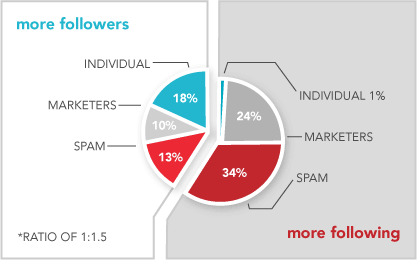Twitter Notification Email Spam
If you are like me, you’ve been hammered with so many “SomeUser is now following you on Twitter!” emails that you just can’t be bothered to care anymore. At SXSW, I declared new follower bankruptcy and simply deleted all of the emails. It’s a shame, though, because I’m sure I’m missing friends, both new and old.
I don’t want to receive any email at all from users that follow more folks that follow them back. Maybe 1:1 is too harsh, so you could use 1:1.5. Ideally, each user would be able to set their own custom threshold. That’s it. I did a little analysis of my last 100 followers to see what effect this simple filter would have. Right off the top, this would eliminate more than half of my new follower notices, almost entirely commercial interests or outright spammers.

I realize that spammers and marketers would adjust their tactics to dodge this simple filter. They could be more aggressive in following and then unfollowing the folks that don’t follow back to keep their ratios below the range. It seems like this would raise a big red flag for Twitter to be able to block them accordingly.
It would also point out to new (and old) marketing interests that following tons and tons of people isn’t the best way to make friends. This would hopefully encourage better behavior from legitimate businesses.
One objection to this is that it would make it hard for new users to get started. I would argue that they can @reply the people they are interested in. I’ve seen several established members of the community send out a tweet welcoming a new user to the group.
Recognizing that there is a continuum of ways twitter can be used, I broke it down into three broad categories. I defined an individual as someone without an overtly commercial interest. These were people I thought were following me because they genuinely wanted to read my tweets. Marketing included companies and non-profits. There were a couple of folks that represented themselves under their own name, but were clearly there on behalf of a company. I marked an account as spam if they had a fraudulent-looking product or were generally obnoxious.
A couple users defied categorization. Take @threewolfman as an example. I marked him as an individual because he had no obvious profit motive, but he wasn’t there representing himself. @lucky22469 was just gaming the system to get as many followers as possible, only for ego it appears. There weren’t enough fake accounts and miscellaneous following me to warrant their own category.
Interested in my methodology? Check out the spreadsheet where I cranked out the numbers in the shared google doc.